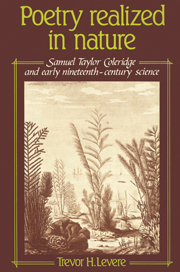Book contents
- Frontmatter
- Contents
- Preface
- Introduction: nature and mind
- CHAPTER 1 Early Years: From Hartley to Davy
- CHAPTER 2 Surgeons, Chemists, and Animal Chemists: Coleridge's Productive Middle Years From the Biographia Literaria to Aids to Reflection
- CHAPTER 3 Two Visions of the World: Coleridge, Natural Philosophy, and the Philosophy of Nature
- CHAPTER 4 Coleridge and Metascience: Approaches to Nature and Schemes of the Sciences
- CHAPTER 5 The Construction of the World: Genesis, Cosmology, and General Physics
- CHAPTER 6 Geology and Chemistry: The Inward Powers of Matter
- CHAPTER 7 Life: Crown and Culmination
- Notes
- Index
CHAPTER 3 - Two Visions of the World: Coleridge, Natural Philosophy, and the Philosophy of Nature
Published online by Cambridge University Press: 09 October 2009
- Frontmatter
- Contents
- Preface
- Introduction: nature and mind
- CHAPTER 1 Early Years: From Hartley to Davy
- CHAPTER 2 Surgeons, Chemists, and Animal Chemists: Coleridge's Productive Middle Years From the Biographia Literaria to Aids to Reflection
- CHAPTER 3 Two Visions of the World: Coleridge, Natural Philosophy, and the Philosophy of Nature
- CHAPTER 4 Coleridge and Metascience: Approaches to Nature and Schemes of the Sciences
- CHAPTER 5 The Construction of the World: Genesis, Cosmology, and General Physics
- CHAPTER 6 Geology and Chemistry: The Inward Powers of Matter
- CHAPTER 7 Life: Crown and Culmination
- Notes
- Index
Summary
A world of little things
Coleridge's objections to mechanism were all interdependent, but the imputation of atheism came to be the fundamental objection, just as theological preoccupations filled his later notebooks. At every state, he sought to keep his interpretation of nature, his philosophy, and his theology in step with one another. The tripartite organization of his first educational schemes was maintained over the years. “True Philosophy,” he wrote in 1817, “… takes it's root in Science in order to blossom into Religion.” Science in itself was morally neutral, but it provided materials for the construction of philosophy, which in turn supported and was transcended by theology. Atheism, in contrast, meant for Coleridge the end of reason and purpose in nature, the end of any possibility of rational knowledge or purposeful action. In an early note, Coleridge proposed to introduce into a poem “a dissection of Atheism – particularly the Godwinian System of Pride Proud of what? An outcast of blind Nature ruled by a fatal Necessity.” He believed that blind Nature and fatal Necessity followed inevitably from atheism and materialism, and he indentified two kinds of materialists and atheists. The first kind assumed that everything was material, that the atoms of matter were endowed with the passive attributes of figure and movability, and that thought and sensation arose from the accidental organization of atoms. The second kind added the active properties of self-movement and life to atoms and derived thought not from the mere arrangement of atoms, but from the aggregation of the properties essential to atoms.
- Type
- Chapter
- Information
- Poetry Realized in NatureSamuel Taylor Coleridge and Early Nineteenth-Century Science, pp. 58 - 81Publisher: Cambridge University PressPrint publication year: 1981

